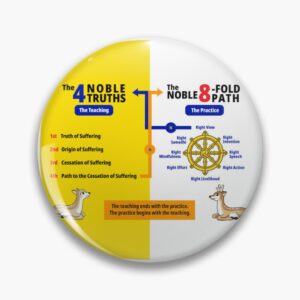
Right view is the “forerunner” of the Noble Eightfold Path,[1] which is why the Buddha listed it first. Having the right view guides the practice. Right view is like having the right map, while the other seven are like having a good vehicle. The right map guides you toward the right direction. It does not matter how good your vehicle is if you are heading the wrong way. So, in that sense, right view may be the most important of the eight.
Okay, if it is that important, what is it? The Buddha said right view is knowing the nature of suffering, the causes of suffering, the nature of liberation from suffering, and the path to liberation from suffering.[2] In other words, knowing the Four Noble Truths.
To be fair, right view is actually a big topic. Sāriputta, the Buddha’s wisest disciple, delivered an important discourse titled (get ready for a surprise … drumroll …) the Discourse on Right View and it covers a host of topics: wholesome versus unwholesome; nutriment; the Four Noble Truths; aging and death; birth; being; grasping; craving; feeling; contact; the sixfold base; mentality-materiality; consciousness; formations; ignorance; taints.[3] Phew. Not that there’s anything wrong with Sāriputta’s discourse, it’s actually very good and very useful, but I think this was another genius move by the Buddha. The Buddha was able to reduce right view to a minimum set which everything else can be reduced to, and from which everything else can be derived, which is the Four Noble Truths. I think the difference between Sāriputta and the Buddha is that while Sāriputta is a genius, and the Buddha is the genius among geniuses. It is not that the Buddha never elaborated on the topic, he did it quite a lot, for example, he famously named sixty-two wrong views in one go in the Discourse on the Supreme Net[4], but when he had to, he could reduce the whole topic into three words in English: Four Noble Truths.
We can think of the Four Noble Truths as the teaching of the Dharma, and the Noble Eightfold Path as the practice of the Dharma. Hence, by defining right view as the Four Noble Truths, the teaching (Four Noble Truths) ends with the practice, and the practice (Noble Eightfold Path) begins with the teaching, thus we get the additional benefit of fortifying the internal consistency between the teaching and the practice.
Activities
References
[1] Majjhima Nikāya 117.
[2] Saṃyutta Nikāya 45.8.
[3] Sammā-diṭṭhi Sutta (Majjhima Nikāya 9).
[4] Brahmajāla Sutta (Dīgha Nikāya 1).
Featured image by Colin Goh.
Sharing Joy and Wisdom with our Buddhist Art
Our team is honored to work with talented artists to create meaningful Buddhist art. To share these creations more widely, we are offering them on thoughtfully crafted merchandise. We hope these items can serve as gentle reminders and companions to inspire wisdom, compassion, and joy in daily life. [Learn More].
Explore our entire Buddhism.net collection here.
Explore the Four Noble Truths and Noble Eightfold Path design collection here.






Merchandise highlights from this design collection


